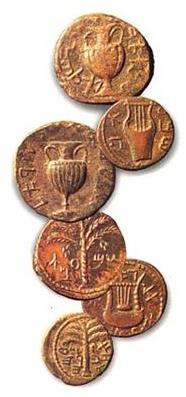"The freedom of Israel"
Like footprints in the sand, coins can mark the presence of people who left no other remains. These coins, minted during the Second Jewish Revolt against Rome (132–135 A.D.) led by the charismatic Bar-Kokhba, read either “year 1,” “year 2” or “year 3.” They display symbols typically found on coins of the revolt- lyres, two-handled amphorae and seven-branched palm trees. All are inscribed in the ancient Hebrew script used a millennium earlier, at the time of the Davidic and Solomonic monarchies—an expression of the rebels’ identification with a glorious past, when Israel was an independent nation. The inscription around the vessel on the third coin from the top reads “the Freedom of Israel.”
Second Jewish Revolt coins were found in Judean Desert caves, from the Wadi Daliyeh near Jericho in the north to Nahal Se’elim near Masada in the south. While Bar-Kokhba’s revolt traditionally is said to have ended with the capture of his fortress at Bethar, author Ze’ev Meshel disagrees. He contends that some rebels retreated to caves in the Judean Desert where, as in the earlier rebellions against Rome, guerrilla warfare persisted until Roman power eventually won out.
“Questioning Masada- Governments-in-Exile; The Judean wilderness as the last bastion of Jewish revolts,” BAR, Nov-Dec 1998.
See also-
- Bar Kokhba Coin, 132-135 CE
- Bronze coin portraying a palm tree, marks year 2 of the Bar Kokhba Revolt, 133 CE (front).
- Bronze coin portraying a vine leaf and the Hebrew inscription, “year two of the freedom of Israel,” 133 CE (reverse).
- Silver coin marking year 3 of the Bar Kokhba Revolt portraying facade of the Jerusalem Temple inscribed with the name Shim’on, 134 CE (front).
- Silver coin marking year 3 of the Bar Kokhba Revolt imposed on a Roman coin portraying the four species and the Hebrew inscription, “for the freedom of Jerusalem,” 134 CE (reverse).

